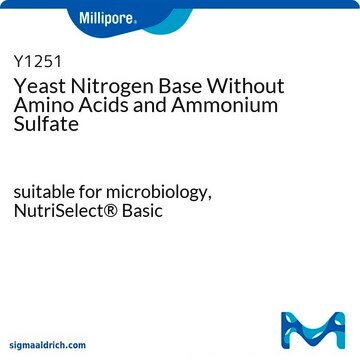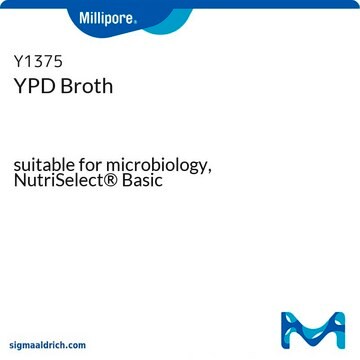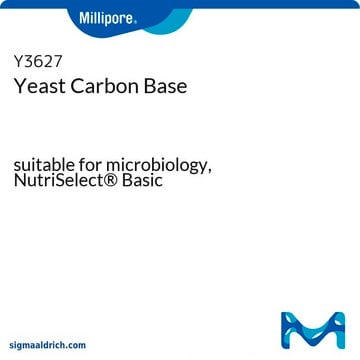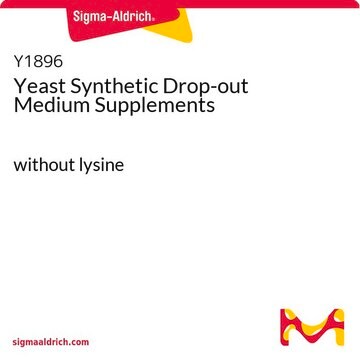Autoclaving is not recommended with glucose/dextrose according to the product information sheet for this product. However, autoclaving can be performed without the sugar, and filter sterilized glucose/dextrose can be added afterward.
Y0626
Yeast Nitrogen Base Without Amino Acids
Yeast classification medium used for selecting yeasts based on amino acid and carbohydrate requirements
Sinonimo/i:
ynb without amino acids
Scegli un formato
Scegli un formato
About This Item
Prodotti consigliati
Grado
Molecular Biology
for molecular biology
Livello qualitativo
Sterilità
non-sterile
Stato
powder
tecniche
microbe id | utilization test: suitable
microbiological culture: suitable
pH
5.2-5.6(0.67% solution)
applicazioni
food and beverages
microbiology
Temperatura di conservazione
room temp
Compatibilità
nonselective for Candida spp.
nonselective for Pichia spp.
nonselective for Saccharomyces spp.
nonselective for Zygosaccharomyces spp.
yeasts
Descrizione generale
Applicazioni
- in synthetic complete supplement mixture (SC)-Leu media used for Y. lipolytica culturing[2] and characterization[3]
- as a component of selective liquid media for uracil auxothrophic growth in yeast[4]
- to evaluate the transformation efficiencies of S. cerevisiae strains, under different nutrient conditions[5]
Componenti
Nitrogen Sources:
Ammonium sulfate, 5.0 g/L
Vitamins:
Biotin, 2.0
Calcium pantothenate, 400
Folic acid, 2.0
Inositol, 2.0 mg/L
Nicotinic acid, 400
p-Aminobenzoic acid, 200
Pyridoxine HCl, 400
Riboflavin, 200
Thiamine HCL, 400
Trace Elements:
Boric acid, 500
Copper sulfate, 40
Potassium iodide, 100
Ferric chloride, 200
Manganese sulfate, 400
Sodium molybdate, 200
Zinc sulfate, 400
Salts:
Potassium phosphate monobasic, 1.0 g/L
Magnesium sulfate, 0.5 g/L
Sodium chloride, 0.1 g/L
Calcium chloride, 0.1 g/L
Nota sulla preparazione
2. Warm if necessary to solubilize and sterilize by filtration.
Store 10× stock solution at 2-8 °C. To use, dilute 1:10 with sterile distilled water under aspetic conditions.
Prodotti correlati
Codice della classe di stoccaggio
13 - Non Combustible Solids
Classe di pericolosità dell'acqua (WGK)
WGK 1
Punto d’infiammabilità (°F)
Not applicable
Punto d’infiammabilità (°C)
Not applicable
Dispositivi di protezione individuale
Eyeshields, Gloves, type N95 (US)
Scegli una delle versioni più recenti:
Possiedi già questo prodotto?
I documenti relativi ai prodotti acquistati recentemente sono disponibili nell’Archivio dei documenti.
I clienti hanno visto anche
Articoli
SeqPlex™-I WTA kit amplifies RNA for NGS, enabling genomic studies from limited samples.
Traditional methods are based morphology, staining methods, enzyme reactions (metabolism) and diverse media.
Protocolli
Magnetic-plasmonic nanoparticles: Synthesis and application of Ag/FeCo/Ag nanobeads for cellular organelle imaging and isolation.
Yeast culture techniques: Model systems for eukaryotic studies with liquid media or agar plate growth.
Contenuto correlato
KOD One™ PCR Master Mix overview for ultra-fast PCR with high specificity, fidelity, and yield
-
Why is autoclaving this not recommended?
1 answer-
Helpful?
-
-
Can this be autoclaved, or only filter sterilized?
1 answer-
It is not recommended to autoclave Product Y0626 Yeast Nitrogen Base Without Amino Acids. If preparing an bacteriological agar, then the agar should be autoclaved separately for 15 minutes only. Please follow the instructions listed on the product detail page:
1. Prepare a 10× stock solution by suspending 6.7 g of yeast nitrogen base, 5 g of glucose or an equivalent amount of other carbohydrate, and 5-10 mg of the desired amino acid in 100 ml of distilled water.
2. Warm if necessary to solubilize and sterilize by filtration.
Store 10× stock solution at 2-8 °C. To use, dilute 1:10 with sterile distilled water under aspetic conditions.Helpful?
-
Active Filters
Il team dei nostri ricercatori vanta grande esperienza in tutte le aree della ricerca quali Life Science, scienza dei materiali, sintesi chimica, cromatografia, discipline analitiche, ecc..
Contatta l'Assistenza Tecnica.














